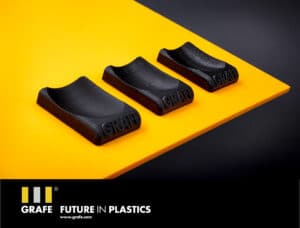GRAFE develops new update for matting agent in 3D printing
Donnerstag, 28.04.2022

The continuous development of the matting agent for 3D printing is characterized by significantly improved matting effects compared to its predecessor and substantially higher print quality. GRAFE, headquartered in Blankenhain, Germany, has tested the product extensively with PETG material. “The trial phase has been completed, initial sampling is underway, and now commercialization begins,” said Lars Schulze, Head of Color Development and Material Sciences, who is overseeing the project. Possible applications include living room elements such as lamps, covers, or switches, as well as other applications in the home.
According to him, subjective examinations using test specimens and metrological analyses show a clear and verifiable reduction in gloss compared with the previous development. In tests at an angle of 60 degrees, the measured value for black-colored PETG was reduced from 8.8 with the help of the old matting agent to 2.6 and even to 1.3 thanks to the new product, the expert reports.
“We can therefore speak with a clear conscience here of a halving of the gloss level compared to the predecessor,” assures the project supervisor. He adds that the matting agent can be metered at 15 percent* and combined with any color batch or compound – without any significant effect on the color. “This is an important property,” according to Schulze.
UPDATE 11/06/2023: Thanks to the continuous optimisation processes at GRAFE, the developers have succeeded in improving the production of the matting agent to such an extent that the initial dosage of 15 percent (in the colour batch or compound) has been reduced to 7.5 percent.
The matting effect is created by diffuse light scattering on the surface of the plastic, the expert said. Customers benefit from a velvety feel with corresponding components. The undesirable visual layer buildup, which often occurs in 3D printing, is barely visible. “The material almost looks like it was cast from a single mold,” Schulze reports. Tests have also shown no adverse effects on the UV resistance of the plastic, he adds.
“3D printing is a rapidly growing market for which we do extensive development work and offer a variety of solutions,” Schulze explains, pointing out that GRAFE works with all major filament manufacturers. PETG stands for PET, which has been processed with glycol. It enjoys great popularity in 3D printing. The solid and resistant material features good thermal stability and robust mechanical properties.
In addition, the matting agent has already been tested for PLA and PC, reports Schulze, who also announces trials with other materials. In addition, he says, trials in injection molding and extrusion processes have also shown significant effects in reducing gloss levels. “We would like to invite our customers to conduct further tests on their premises and see the matting effect for themselves,” the expert says.
